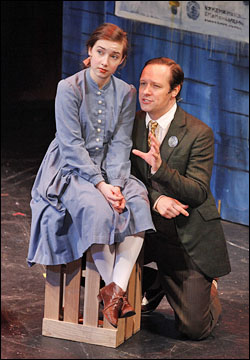SITE GUIDE
SEARCH
REVIEWS
REVIEW ARCHIVES
ADVERTISING AT CURTAINUP
FEATURES
NEWS
Etcetera and
Short Term Listings
LISTINGS
Broadway
Off-Broadway
NYC Restaurants
BOOKS and CDs
OTHER PLACES
Berkshires
London
California
New Jersey
DC
Connecticut
Philadelphia
Elsewhere
QUOTES
TKTS
PLAYWRIGHTS' ALBUMS
LETTERS TO EDITOR
FILM
LINKS
MISCELLANEOUS
Free Updates
Masthead
A CurtainUp Review
A Tree Grows in Brooklyn
|
Katie, don't look that way. We'll get by. Don't I always find a way?— Johnny Nolan
|

Keaton Whittaker and Jim Stanek
(Photo by Carol Rosegg) |
The play has a book by George Abbott and Betty Smith (who it turns out, always wanted to be a playwright) music by Arthur Schwartz and lyrics by Dorothy Fields. In 1951, when it opened at the Alvin Theater, it received mixed reviews. Although most critics liked the score, they thought various problems plagued the show, including a book that deviated from Smith's wiser original intentions.
Peccadillo has attempted to correct past mistakes with a book that has been revised by Elinor Renfield with Susan DiLallo. Not being very familiar with the original version, I can't make a comparison, but I can say that book and score in this staging work as organically as a tree growing from the soil.
A Tree Grows in Brooklyn tells the story of Francie Nolan (Keaton Whittaker, who also serves as narrator), a young girl who grew up in Williamsburg, Brooklyn in the early 1900s. Her father, Johnny (Jim Stanek), is a charming alcoholic and a singing waiter who can't keep a job. Her mother, Katie (Elizabeth Loyacano) is a once beautiful woman whose heart and hands have been chafed by hard work and troubles.
It might have had something to do with the fact that this reviewer saw the show on St. Patrick's Day, but it seemed that Stanek was born to play an Irish tenor and woo Loyacano, a soprano whose voice, when at full-throttle, could make the rocks weep. It's hard not to love them and wish them well, knowing full well their romance will not have a happy ending.
A host of wonderful minor characters, including Katie's lovable but promiscuous sister Cissy (Klea Blackhurst), make the story particularly entrancing. Blackhurst, who has the voice and looks of an Ethel Merman returned to life, could easily steal the show if the leads were not so powerful.
Although flats swing open for interior scenes, Joseph Spirito's basic set is a Brooklyn street. This is where the ensemble, dressed in period clothing designed by Amy C. Bradshaw, sings numbers such as "Payday", "Love is the Reason" and "Look Who's Danciin'". There is considerable doubling and tripling of parts among the m to allow the musical to fully portray the flavor of street life in Brooklyn. "Nightmare Interlude" is a particularly fine example of Richard Stafford's choreography.
Strong singing, dancing and acting make the cast look much fuller than it actually is (at 17, it's already quite large for an off-Broadway show). Indeed this production has the look and feel of Broadway. One can easily see it in a bigger house on a larger stage.
The genteel poverty described in A Tree Grows in Brooklyn is most certainly a work of the various artists who created and staged this play. But, of course, it comes from an older era in which musicals did not mirror the real world but brought the audience into a brighter, happier and more fascinating one.
|
A Tree Grows in Brooklyn Book by George Abbott and Betty Smith. Revised book by Elinor Renfield and further revisions by Susan DiLallo Music by Arthur Schwartz Lyrics by Dorothy Fields Directed by Dan Wackerman Cast: Cast: Jim Stanek (Johnny), Elizabeth Loyacano (Katie), Keaton Whittaker (Francie), Klea Blackhurst (Cissy), Timothy Shew (Oscar), Lianne Marie Dobbs (Hildy), Jason Simon (Aloysius), Thursday Farrar (Nellie). The cast also includes Matthew Bauman, Lauren Blackman, Jack Doyle, Christopher Kauffmann, Michael McGurk, Leah Landau, Kenny Morris, Johnny Stellard, and Toni Elizabeth White Music Direction: Kristen Blodgette Choreography: Richard Stafford Scenic Design: Joseph Spirito Lighting Design: Kate Ashton Costume Design: Amy C. Bradshaw Sound Design: Jeremy Wilson Graphic Design; Frank Dain Dialect Coach: David Wells Stage Manager: Ernie Fimbres Running Time: 2 hours, 30 minutes with one intermission Peccadillo at Theatre at St. Clements, 423 W 46th Street, 212-352-3101 ThePeccadillo.com From 3/12/11; opening 3/20/11; closing 4/10/11 (a 1-week extension before |
|
REVIEW FEEDBACK Highlight one of the responses below and click "copy" or"CTRL+C"
Paste the highlighted text into the subject line (CTRL+ V): Feel free to add detailed comments in the body of the email. . .also the names and emails of any friends to whom you'd like us to forward a copy of this review. Visit Curtainup's Blog Annex For a feed to reviews and features as they are posted add http://curtainupnewlinks.blogspot.com to your reader Curtainup at Facebook . . . Curtainup at Twitter Subscribe to our FREE email updates: E-mail: esommer@curtainup.comesommer@curtainup.com put SUBSCRIBE CURTAINUP EMAIL UPDATE in the subject line and your full name and email address in the body of the message. If you can spare a minute, tell us how you came to CurtainUp and from what part of the country. |

Slings & Arrows-the complete set
You don't have to be a Shakespeare aficionado to love all 21 episodes of this hilarious and moving Canadian TV series about a fictional Shakespeare Company






